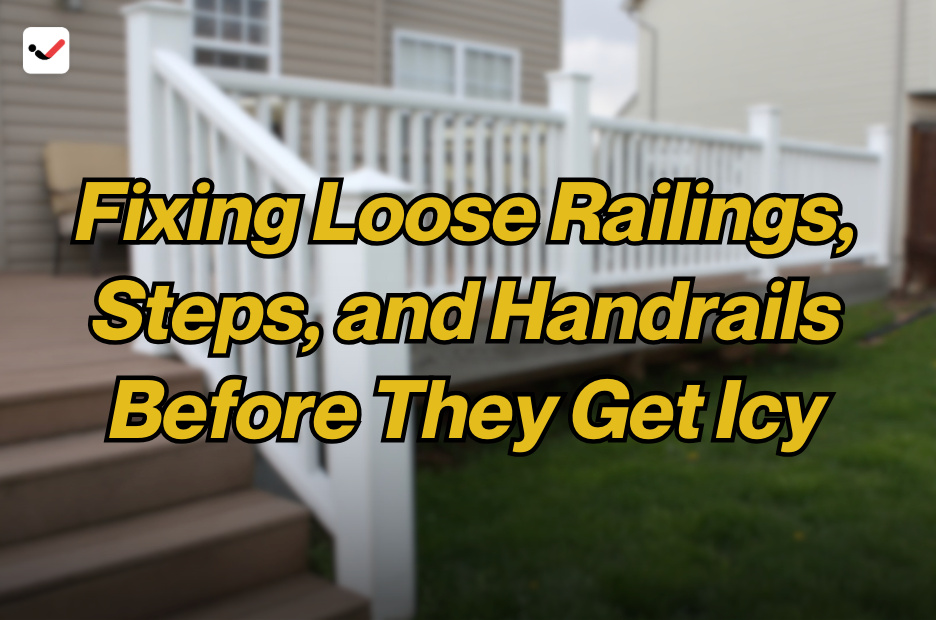Fixing Loose Railings, Steps, and Handrails Before They Get Icy
Fixing Loose Railings, Steps, and Handrails Before They Get Icy

As temperatures drop and the first signs of frost appear, outdoor safety becomes more important than ever. Steps, porches, and entryways can quickly become slippery from morning dew, rain, or early snowfall. If your home has loose railings, cracked steps, or unstable handrails, the risk of slipping and falling increases when ice forms. These small repair jobs may seem minor now, but once the cold sets in, they can become serious hazards.
Getting ahead of the weather with basic home maintenance helps prevent accidents and costly emergency repairs. Fixing steps and handrails before winter is not just about keeping your property looking good — it’s about protecting your family, guests, and anyone who comes to your door. In this article, we’ll go through what to check, how to fix it, and why it’s essential to take care of loose railings and damaged stairs before freezing temperatures arrive.
1. Why Loose Railings and Steps Are Dangerous in Winter
When steps or handrails are loose, they offer little support. Add ice, snow, or even wet leaves, and they become dangerous fast. In winter, people rely more on railings to stay balanced, especially when walking up or down icy steps. A shaky railing or broken step can lead to serious falls and injuries.
In colder regions, ice can hide small cracks or uneven surfaces. Without a sturdy handrail, a person slipping has nothing to grab. Loose or broken steps may also collect water that freezes overnight, turning into hidden ice patches. Fixing these issues in fall is key to keeping your outdoor spaces safe.
2. Inspect Your Stairs, Steps, and Railings Early
Start by doing a full check of your front steps, porch stairs, backyard deck, and any handrails or guardrails around your home. Use your hands to wiggle each railing or post. If it moves, even slightly, it needs to be secured. Walk up and down your steps slowly to feel for shifting boards, soft spots, or cracks.
Also, look at the hardware. Screws or bolts that are rusted or missing should be replaced. Check if the handrail is level and firmly attached at both ends. This kind of outdoor home inspection is simple and can help you avoid emergency repairs later when everything is covered in ice or snow.
3. How to Fix Loose Railings
Fixing a loose railing often means tightening or replacing the screws or bolts that hold it in place. Use weather-resistant fasteners, especially if the railing is exposed to snow and rain. If the wood is rotting or the anchor point is damaged, it may need to be reinforced or rebuilt.
If your railings are attached to concrete or brick, make sure anchors are still solid. In some cases, you may need to drill new holes and use concrete anchors or epoxy to get a secure fit. Adding metal brackets or braces underneath can also improve strength. Strong railings are key for winter home safety and fall prevention.
4. Repairing Damaged or Cracked Steps
Cracked concrete steps should be sealed before freezing temperatures arrive. Water can seep into cracks and expand when it freezes, making the damage worse. Use a concrete patch product for small cracks or hire a contractor for major repairs.
For wooden steps, check for soft or spongy spots. These are signs of rot. Replace damaged boards and secure them with galvanized nails or screws. If your steps are loose, reinforce the frame underneath. Solid stairs reduce the risk of tripping, especially when they’re wet or icy.
5. Strengthening Handrails on Porches and Decks
Handrails are not just for support — they’re a major safety feature in cold weather. Many people use them to brace themselves while walking on slippery surfaces. A wobbly or leaning handrail can collapse under pressure, especially if it’s used to prevent a fall.
To strengthen porch railings, check all joints and connection points. Reinforce any weak areas with additional brackets. For older wooden railings, tighten all screws and apply a protective sealant to prevent moisture damage. A solid handrail gives confidence to anyone walking on frosty or icy paths.
6. Use Non-Slip Materials and Finishes
Even when steps and railings are secure, winter conditions can still be risky. Adding non-slip strips or treads to stairs can reduce the chance of slipping. These adhesive strips are easy to apply and are available for both wood and concrete.
For decks and porches, consider using anti-slip paint or sealant. This type of coating adds grip to surfaces and protects against moisture. Adding grip to steps and walkways is one of the easiest ways to improve winter safety around your home.
7. Don't Wait for Snow to Start Repairs
Once snow falls or ice forms, it becomes harder — and more dangerous — to do repairs. Tools freeze, wood becomes brittle, and working outdoors gets uncomfortable fast. That’s why early fall is the best time to fix loose steps, railings, and other outdoor safety features.
Doing home maintenance before winter not only protects your property, it also saves you time and money. Emergency repairs in cold weather often cost more and may not last as long. By fixing problems early, you’re getting ahead of the season and keeping your home safer.
8. Protecting Your Home and Your Guests
Many homeowners forget how dangerous small repairs can become in the cold. A single icy step or loose railing can lead to a serious injury — and if a guest gets hurt, you could be liable. Preventing slips and falls around your home is part of responsible homeownership.
This is especially important for homes with seniors, kids, or anyone with mobility issues. Strong, secure railings and safe steps can make all the difference when the walkway is slippery or covered in frost.
9. Regularly Check After Freezes
After the first frost or freeze, check your steps and railings again. Ice and snow can loosen fasteners or reveal new damage. If you see movement or cracks, repair them right away. Quick fixes now prevent bigger problems later.
It’s also a good idea to sweep off leaves and snow from steps and porches. Wet leaves can be just as slippery as ice. Keeping walkways clean is part of regular winter safety maintenance.
Loose steps and shaky handrails are problems that only get worse with time — and winter weather speeds up the damage. If you live in a place where snow and ice are part of daily life, fixing these issues before the cold sets in is one of the smartest things you can do for home safety.
Take a weekend to inspect your outdoor areas, tighten what’s loose, replace what’s damaged, and add traction where needed. A few simple repairs now can prevent injuries, save you money, and give you peace of mind all winter long.

